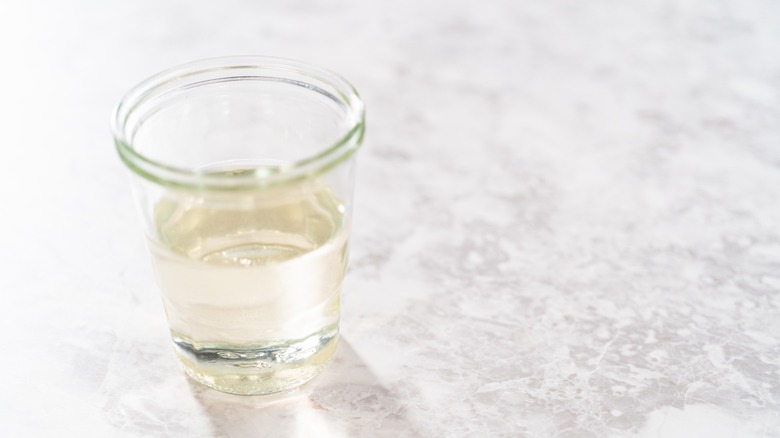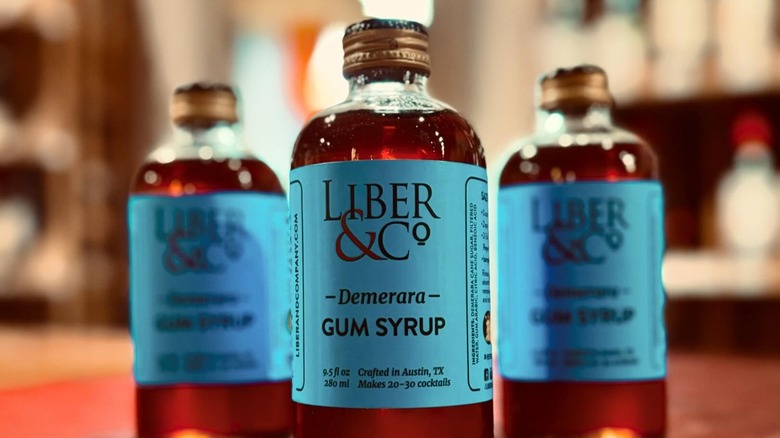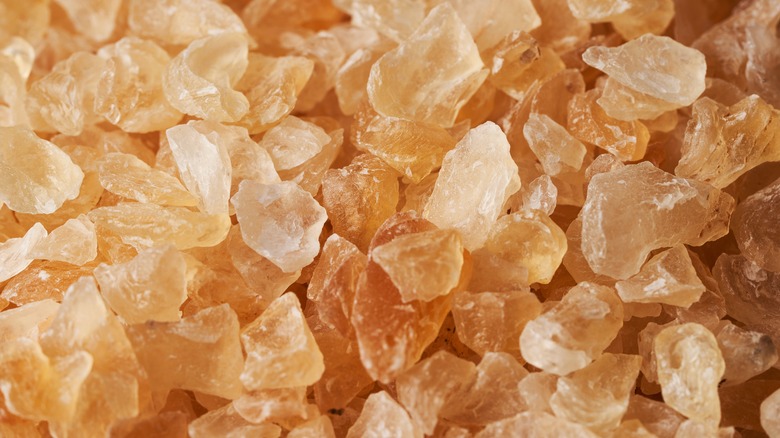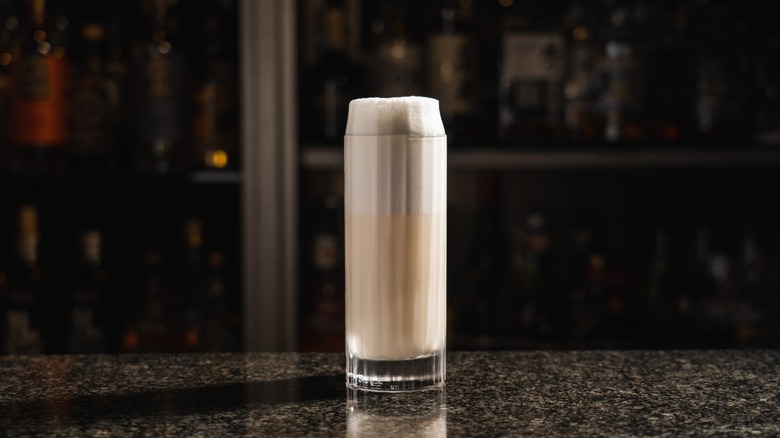The Subtle Difference Between Gum Syrup And Simple Syrup In Cocktails
Any cocktail bartender worth their salt will tell you that the key to a perfect cocktail is balance. Cocktails can be sweet, tart, bitter, or boozy, but these flavor profiles need to harmonize with one another without becoming too dominant. Increasing the sweetness of a drink is a highly effective way to temper spicy or sour flavor profiles, and some people just happen to find saccharine drinks more palatable. There are two ingredients that bartenders usually rely on to boost the sweetness of drinks without impacting their actual flavor: simple syrup and gum syrup.
However, although unadulterated simple syrup and gum syrup taste pretty much identical, the latter includes an additional ingredient called gum arabic. This extra element leads to a far more viscous syrup which can round out thinner drinks and give cocktails a much more luxurious mouthfeel. In most cases, the two syrups are interchangeable. Gum syrup does taste slightly less sweet than simple syrup, so you may need to increase the amount you're using to achieve the same results.
What is simple syrup?
Simple syrup is the most common ingredient that bartenders use to make a cocktail taste sweeter, and it really is as straightforward as the name implies. It requires no specialist equipment or ingredients to make, and no culinary abilities more advanced than being able to boil a pot of water.
The basic recipe for simple syrup only involves stirring granulated sugar into boiling water in a 1:1 ratio. You stir the sugar until it's completely dissolved then wait for the concoction to cool, and voilà. Simple syrup is a much better way to increase the sweetness of a beverage than trying to dissolve solid granules into a cold liquid. Not only does it guarantee an equal distribution of the sugar throughout the drink, but it also side-steps the risk of ending up with undissolved sugar sitting at the bottom of the glass. This is why some baristas also opt for simple syrup — it's by far the quickest and easiest way to sweeten coffee.
That said, you can still tweak the basic recipe for bonus effects. For rich simple syrup, you can double the amount of sugar. This concentrated version packs more of a punch but it also thickens the mouthfeel of a drink and can make it taste smoother. Additionally, you can use brown sugar for a deeper, molasses-forward taste, or even infuse your syrup with herbs, fruit, or tea to add more character to a cocktail.
What is gum syrup?
While versions of simple syrup have been around since ancient times, gum syrup is a comparatively new invention. It first appeared in the 19th century, when the sweet liquid was used to take the edge off the harsh liquor that was so prevalent pre-Prohibition. Over time, it became a common cocktail ingredient, and while it fell out of favor around the mid-20th century, it's made something of a comeback in recent years.
Simple syrup and gum syrup typically share the same level of sweetness, with both calling for a 1:1 ratio of sugar to water. However, compared to simple syrup, gum syrup has a far greater impact on the mouthfeel of a cocktail. Gum syrup gives cocktails a much smoother, silkier texture, which can also temper the heat of stronger, boozier ingredients. This is because gum syrup includes a special ingredient: gum arabic. Due to the nature of gum arabic, making gum syrup is a little more complex than making simple syrup. First, the powdered gum arabic must be mixed into a paste using cold, filtered water, which can take around 10 minutes of continuous stirring. Only then can the mixture be gently heated and the sugar added.
It's also worth pointing out that gum syrup is commonly referred to as gomme syrup. Gomme is the French word for gum, and it's likely used because it's predominantly French companies that produce this type of syrup.
Gum syrup contains gum arabic
In terms of ingredients, the key difference between simple syrup and gum syrup is that the latter includes a component called gum arabic. While the word gum makes many of us think of the chewable confectionery, it's also the name used for natural, soluble tree sap that hardens as it dries.
Gum arabic is a specific type of gum that comes from two kinds of acacia trees: Vachellia seyal and Senegalia senegal. The former can be found in the African Sahara and Arabian Peninsula, while the latter is located in sub-Saharan Africa, India, and parts of the Middle East. Today, the majority of our gum arabic — about 50 percent — comes from Sudan. The crystallized sap is finely ground into a white powder which has many different uses. Gum arabic is a common stabilizing ingredient within the food and pharmaceutical industries, but it's also used as a binding agent in dyes, making it invaluable for artists, printers, and the cosmetics industry.
It's likely that gum syrup fell out of favor in the 20th century due to it being too difficult to source gum arabic. These days, it's much easier to get hold of and is relatively inexpensive. Still, many bartenders prefer to buy pre-made gum syrup, as the low cost is worth the time they'd spend preparing it themselves.
Gum syrup has emulsifying properties
The other main feature of gum syrup that sets it apart from simple syrup is that it has emulsifying properties. Emulsifiers are substances that allow us to mix liquid ingredients that normally don't like being combined, such as oil and water.
Many cocktails include ingredients that don't play well together on a chemical level and can benefit from using gum syrup. Although oily components aren't extremely common, ingredients like mint contain natural oils, while fat-washed spirits can separate in a drink without an emulsifier. The liquids in cocktails that include dairy can also split apart. For example, the notoriously labor-intensive Ramos Gin Fizz contains heavy cream, lemon juice, and lime juice, and adding gum syrup can help prevent the dairy component from curdling.
Additionally, sour cocktails that contain egg whites require a vigorous dry shake to emulsify the ingredients, but gum syrup can help stabilize them. The stabilizing properties are also handy if you're making Tiki cocktails, as these frequently call for numerous fruit juices, spirits, and syrups that can make it tricky to achieve a perfectly uniform consistency.




